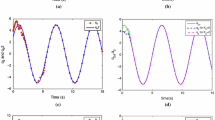Abstract
This paper deals with the problem of robust output feedback control for a class of 5DOF upper-limb exoskeleton robot. It is able to assist with shoulder, elbow and wrist joint movements. Robustness is assured for the proposed controller in the presence of model uncertainties. Ultimate boundedness is proved for the presented adaptive observer-based controller. The other advantage of the proposed method is that the implemented information for feedback is only the measurement of position. The estimation of velocity and acceleration is provided by an adaptive observer without additional sensors. By utilizing a novel adaptive logic-based switching control scheme, a trajectory tracking performance is well achieved with a tunable error bound. The simulation example also verifies the effectiveness of the proposed control scheme.
Similar content being viewed by others
References
G. B. Prange, M. A. Jannick, C. G. M. Groothuis-Oudshoorn, H. Hermens, and M. J. Ijzerman, “Systematic review of the effect of robot-aided therapy on recovery of the hemiparetic arm after stroke,” J. Rehab. Res. Dev, vol. 43, no. 2, pp. 171–184, 2006.
G. Kwakkel, B. J. Kollen, and H. I. Krebs, “Effects of robot assisted therapy on upper limb recovery after stroke: a systematic review,” Neurorehab. Neural Repair, vol. 22, no. 2, pp. 111–121, 2008.
H. T. Hendricks, J. van Limbeek, A. C. Geurts, and M. J. Zwarts, “Motor recovery after stroke: a systematic review of the literature,” Arch. Phys. Med. Rehab, vol. 83, no. 11, pp. 1629–1637, 2002.
K. J. Hunt, M. Munih, and N. de Donaldson, “Feedback control of unsupported standing in paraplegia- Part I: optimal control approach,” IEEE Trans. Rehab. Eng, vol. 5, no. 4, pp. 331–340, 1997.
K. J. Hunt, R. P. Jaime, and H. Gollee, “Robust control of electrically stimulated muscle using polynomial H ∞ design,” Control Eng. Pract., vol. 9, no. 3, pp. 313–328, 2001.
W. Yu and J. Rosen, “A novel linear PID controller for an upper limb exoskeleton,” Proc. of the 49th IEEE Conf. on Decision and Control, pp. 3548–3553, 2000.
T. Nef, M. Mihelj, and R. Riener, “ARMin: a robot for patient cooperative arm therapy,” Medical & Biological Engineering & Computing, vol. 45, pp. 887–900, September 2007.
S. Jezernik, R. G. V. Wassink, and T. Keller, “Sliding mode closed-loop control of FES: controlling the shank movement,” IEEE Trans. Biomed. Eng., vol. 51, no. 2, pp. 263–272, 2004.
C. T. Freeman, A.-M. Hughes, J. H. Burridge, P. H. Chappell, P. L. Lewin, and E. Rogers, “Iterative learning control of FES applied to upper extremity for rehabilitation,” Control Eng. Pract., vol. 17, no. 3, pp. 368–381, 2009.
F. Previdi and E. Carpanzano, “Design of a gain scheduling controller for knee-joint angle control by using functional electrical stimulation,” IEEE Trans. Control Syst. Technol., vol. 11, no. 3, pp. 310–324, 2003.
M. Krstic, I. Kanellakopoulos, and P. Kokotovic, Nonlinear and Adaptive Control, Wiley, New York, 1995.
M. W. Spong and M. Vidyasagar, Robot Dynamics and Control, Wiley, New York, 1989.
H. J. Ma and G. H. Yang, “Adaptive logic-based switching fault-tolerant controller design for nonlinear uncertain systems,” International Journal of Robust and Nonlinear Control, vol. 21, no. 4, pp. 404–428, 2011,3.
H. J. Ma and G. H. Yang, “Adaptive output control of uncertain nonlinear systems with non-symmetric dead-zone input,” Automatica, vol. 46, no. 2, pp. 413–420, 2010.
H. Asada and K. Youcef-Toumi, “Analysis and design of a direct-drive arm with a five-bar-link parallel drive mechanism,” ASME Journal of Dynamic Systems, Measurement, and Control, vol. 106, no. 3, pp. 225–230, 1984.
Q. Li, D. Wang, Z. Du, Y. Song, and L. Sun, “sEMG based control for 5 DOF upper limb rehabilitation robot system,” Proc. of IEEE International Conference on Robotics and Biomimetics, pp. 1305–1310, 2006.
K. B. Kang and J. H. Wang, “Adaptive control of 5DOF upper-limb exoskeleton robot with improved safety,” ISA Transactions, vol. 52, no. pp. 844–852, 2013.
T. Madani, B. Daachi, and K. Djouani, “Adaptive controller based on uncertainty parametric estimation using backstepping and sliding mode techniques: application to an active orthosis,” Proc. of European Control Conference, pp. 1869–1874, 2014.
M. Faieghi and A. Jalali, “Robust adaptive cruise control of high speed trains,” ISA transactions, vol. 53, no. 2, pp. 533–541, 2014.
B. Daachi, T. Madani, M. E. Daachi, and K. Djouani, “MLPNN adaptive controller based on a reference model to drive an actuated lower limb orthosis,” Proc. of 5th IEEE RAS & EMBS International Conference, pp. 638–643, 2014.
Author information
Authors and Affiliations
Corresponding author
Additional information
Hao-Bo Kang received her B.S. and M.S. degrees in Electrical Engineering from Shenyang University of Technology, China, in 2007 and 2011, respectively, where she is currently pursuing a Ph.D. degree in Electrical Engineering. Her research interests include control theory and its application to control of robotic systems.
Jian-Hui Wang received her B.S., M.S., and Ph.D. degrees in Electrical Engineering from Northeastern University, China, in 1982, 1986, and 1999, respectively. Her research interests include intelligent control theory and its application.
Rights and permissions
About this article
Cite this article
Kang, HB., Wang, JH. Adaptive robust control of 5 DOF Upper-limb exoskeleton robot. Int. J. Control Autom. Syst. 13, 733–741 (2015). https://doi.org/10.1007/s12555-013-0389-x
Received:
Revised:
Accepted:
Published:
Issue Date:
DOI: https://doi.org/10.1007/s12555-013-0389-x



